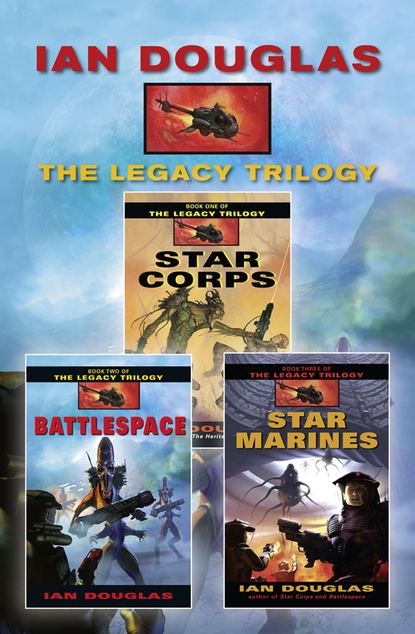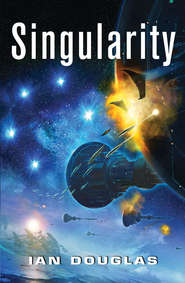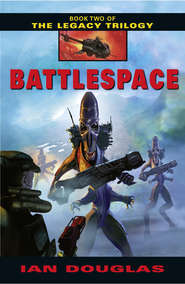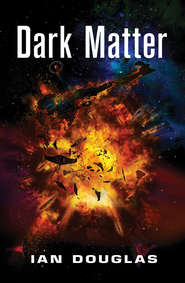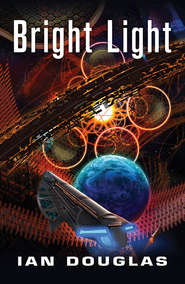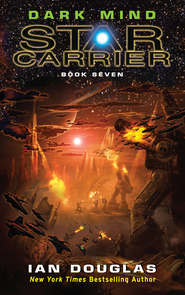По всем вопросам обращайтесь на: info@litportal.ru
(©) 2003-2024.
✖
The Complete Legacy Trilogy: Star Corps, Battlespace, Star Marines
Настройки чтения
Размер шрифта
Высота строк
Поля
The cheer that went up from the mob was audible across two kilometers of open ground. Warhurst felt an uneasy chill, despite the heat of the afternoon. Ibn-Khadir was bringing their fervor to a boil, and it wasn’t hard to guess what would happen next.
“They’re going to try a goddamned puppy rush,” Karelin said, echoing Warhurst’s own thoughts.
A puppy rush. Shit. Most of the people in that crowd were unarmed, as far as Warhurst could tell from the MD-30’s magnified sniperscope image, though a few Chinese and Iranian assault rifles were in evidence. Many were women, many more teenagers and younger. The KOA militia leaders might well have decided to rush the Marine perimeter with civilians, hoping that the Americans wouldn’t “kick the puppies,” that they would at least hesitate and not open fire until armed militiamen could get close enough to begin killing Marines.
The hell of it was that a civilian charge, or an assault shielded by unarmed civilians, was a lose-lose proposition for the Marine defenders. If they held their fire, the enemy would break through the perimeter and be among them; no matter how good the Americans’ mil-tech, they would be too badly outnumbered to survive a close-quarters battle.
But if the Marines opened fire, the up-close-and-personal images of unarmed Islamic civilians being slaughtered at long range would be uploaded to every e-news server on the Net, to be replayed time after time in gory and colorful detail on the viewalls and HVs of half the people on the planet. It would be a moral nightmare from which the UFR might never recover.
But maybe there was a different way.
“Downsize a click,” he told Karelin. “And fire up your see-through.”
“Aye aye, sir.”
The generator in her rifle began spooling up to speed. The view of ibn-Khadir seemed to pull back twenty meters, revealing all of the truck he was standing on and more of the surrounding crowd. “Smile for the camera,” Karelin said, and she fired the X-ray scatter pulse.
The image in Warhurst’s display blanked out, showing nothing but green light. In a few seconds, however, the gun’s computer built up a composite image from the backscattered X rays, an image that turned sheet metal, plastic, cloth, and flesh into faint translucence, revealing denser structures like bone and the solid titanium steel of the hovertruck’s engine block in light green, yellow, and pale green-white.
To avoid burning people in the target area, the pulse lasted for only a handful of nanoseconds, so the initial image was frozen in time. The computer superimposed that image on the real-time view, however, animating it to match the moving reality.
“There,” Warhurst said. “See the flywheel on the drive train?”
“Roger that,” Karelin said. The targeting reticle shifted again, coming to rest over the circular mass of the hovertruck’s flywheel. Dopplered readings on the back-scatter radiation showed that it was in motion.
The Egyptian hovertruck was powered by pretty old tech, a hydrogen-burning power cell array that in turn powered the turbine compressors of two large lift fans in the vehicle’s chassis. The fans were off, the vehicle grounded on its plenum chamber skirts, but the power assembly was still running, storing energy in the massive, fast-spinning flywheel that provided both extra power on demand and gyroscopic balance.
“See if you can nick that wheel,” Warhurst said.
“Ay-firmative, Skipper!” Karelin leaned into the stock of her weapon again. There was a faint whine as its magfield generators came up to full power, and then a piercing crack as she squeezed the trigger.
Gauss rifles, rail guns, mass drivers—all terms for the same simple concept. The MD-30—MD for “mass driver”—was a sniper’s rifle, using an electromagnetic pulse to launch a 250-gram sliver of steel-jacketed depleted uranium with a muzzle velocity of approximately Mach 25.
The truck beneath ibn-Khadir’s feet jerked sharply with the impact, the engine access panels snapping open, the plastic windshield shattering. The impact smashed the engine block wide open, smashed the durasteel-armored flywheel housing, and cracked the flywheel itself. In an instant the truck’s body was flipped into the air, sending the Mullah ibn-Khadir flying in a thrashing tangle of robes and limbs. The vehicle’s steel and plastic shell absorbed most of the high-speed shrapnel from the flywheel, but torque ripped the vehicle open and bounced it onto its roof.
The crowd, cheers turned to shrieks of terror, broke and scattered in all directions. The hovertruck’s hydrogen cells, ripped open by the impact, ignited, sending a ball of orange hydrogen flame blossoming into the sky. In an instant the more or less orderly gathering was reduced to chaotic pandemonium, as civilians and militia troops fled the burning wreckage. Several dozen bodies lay around the truck, hit by shrapnel or stunned by the sonic crack of the hyperprojectile—it was impossible to tell which. Ibn-Khadir was sprawled ten meters from the wreck, weakly moving as two of his braver supporters tried to help him to his feet.
“Taking kind of a chance, aren’t you, Skipper?” Lambeski asked with a matter-of-fact expression. “Burning civilians like that …”
“Burning hydrogen rises,” Warhurst replied. “That’s why only thirty-some people died on the Hindenburg.”
“The what?”
“Never mind. We might have hit a few civilians with flying chunks of truck, but it happened so quickly, I doubt the newsie remotes saw what happened or could reconstruct it. And I don’t think they’ll be eager to try another mob rush, do you?”
“You got that right, sir,” Karelin said. “Look at ’em run!”
She’d stepped the magnification on her scope down to take in the entire sweep of the west bank of the Nile, from El Giza north to the University of Cairo and beyond to the district of El Duqqi. The panicked mob was dispersing back across the Gama and Giza bridges.
The mullahs might be able to assemble the mob again, but it would take time.
And maybe help would arrive by then.
Maybe.
4
5 JUNE 2138
Giza Complex
Kingdom of Allah, Earth
1838 hours Zulu
Like a large and exceptionally ugly beetle, all angles and planes and outstretched landing jacks, the first dropship drifted down out of the evening sky on shrieking plasma thrusters, moving toward the bare patch of desert south of the Sphinx marked by the brilliantly pulsing green landing beacon.
Unlike the suborbital TAVs that had brought in the Marines, these were true spacecraft, big UD-4 Navajo cargo landers generating a million pounds of thrust through their six Martin-Electric plasmadyne jets. Air scoops gaped now, fans howling, gulping down air as reaction mass, saving precious water for higher altitudes, where the air ran thin or trailed away into vacuum.
Sand exploded in swirling clouds from beneath the lander as it touched down, sagging slightly as its hydraulics took up the shock of landing. Belly doors gaped open, interlocking square teeth sliding apart to disgorge eight light Rattlesnake robot tanks, four Cobra medium MBTs, a pair of massive Gyrfalcon mobile artillery crawlers, two twenty-ton cargo floaters, and four armored personnel carriers. The dropship lifted again in a sandblasting whirlwind as soon as its cargo was clear. Other dropships were touching down at marked LZs elsewhere across the Giza Plateau.
Warhurst trotted up to the lead APC, which was just beginning to unbutton. The markings indicated American rapid-deployment infantry. He was surprised, having expected a joint Confederation unit coming in by TAV from the UK, not American troops. And the UD-4s meant they’d deployed from orbit, probably from the Army’s Rapid Deployment Force Orbital Station in low orbit.
A man in an Army active-camo armor cuirass and brown fatigues, with a major’s oak leaf insignia painted on his shoulder pieces and the RDF’s lightning bolt insignia on his breast, clambered down the aft ramp as a line of fully armored troops piled out of the APC and jogged out onto the sand.
“Who’s in charge here?” the major demanded.
“Captain Warhurst, 2nd Regiment, U.S. Marines.” He didn’t salute. Standing orders required a suspension of any military protocol that might allow the enemy to target officers.
“Major Rostenkowski, 5th Light Infantry.”
“Welcome to Egypt, Major.”
“Good to be here. You are relieved, Captain,” the major said. “The Army has the situation in hand.”
“About damned time, Major,” Warhurst said. He turned his head to watch the soldiers falling into line as a sergeant bawled orders at them. “What happened to the Confed relief?” The last he’d heard, his relief was supposed to be a couple of Russian platoons, some light German armor, and a detachment of Brits.
Rostenkowski grinned. “Bogged down in politics, as per SOP. Washington is getting it from all sides these days, and the Confederation isn’t sure they want to play along. The Joint Chiefs elected to send us instead. You and your boys and girls are to hustle ass back to Quantico for debrief. What’s your tacsit?”
“Give me your feed channel, sir.”
They matched ’ware frequencies, and Warhurst thought a packet of detailed tactical data to Rostenkowski’s biocybe system, providing him with detailed information on the initial assault, the counterattack, and the overall situation since.
“Nice twist, using a sniper to discourage that attack,” the major said. “Any civilian casualties?”
“We’re not sure. Our spotters saw ambulance crews picking up four people, but we don’t know if they were dead or just badly hurt when the truck exploded.”
“Well, the important thing was to keep that sort of thing out of the newsies’ eyes. Good work, Captain.”





